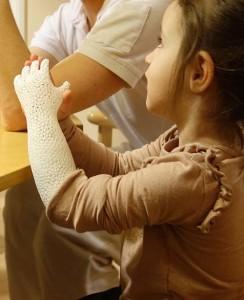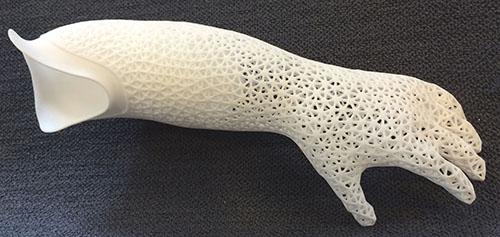Of all the uses that 3D printing technology has provided the medical field with over the past few years, none show as much immediate impact as the production of assistive devices. From communities in Uganda to the veterans of the United States, 3D printed prosthetics have helped improve the lives of many children and adults around the world. Now, Emelie Strömshed, a Master’s student in product development at the Sweden-based Lund University School of Engineering, has developed a simplified process involving a trio of 3D technologies. The process has already helped to create a custom prosthetic arm socket for a young girl named Neya Pfannenstill.
Strömshed has developed a step-by-step process to create the perfect-fitting prosthetic limb, aimed to provide an easy-to follow guide to prosthetists who don’t have a full grasp on CAD. With her research, Strömshed set out to prove that a combination of CAD modeling, 3D scanning, and 3D printing could be used in a simplified process to create more efficient and better fitting prosthetic devices. The process begins with 3D Systems’ iSense 3D Scanner, a low-cost accessory that transforms an iPad or iPhone into a 3D scanner. First, Strömshed offset the limb surface at a distance that was equal to the desired thickness of the 3D printed socket, which was then subtracted from the original 3D scan to create an inner surface that fit Pfannenstill perfectly.
After the scan is repaired and offset to create the hollow socket, the prosthetic design is shaped and smoothed out, imported with electrode modules, and given a unique pattern to suit the preference of the wearer. These electrode modules are then subtracted after the pattern is developed, and are inserted back into the ready-to-use 3D printed socket at the end of the process. The final design is then 3D printed — in Strömshed’s case at least— with a selective sintering system in a strong nylon material, which can also be colored if desired.

Neya Pfannenstill with her new 3D printed prosthetic arm socket
Compared to the traditional methods of prosthetic manufacturing, which generally require skilled manual crafting and a costly amount of casting and molding, Strömshed’s method looks to be a major advancement. Strömshed’s simplified process is meant to give prosthetic technicians without advanced CAD skills the means to produce a perfectly fitting prosthetic socket with 3D printing. Not only did she manage to create a optimal fitting prosthetic for the young Neya Pfannenstill, a time and cost comparison also showed the potential to save around 400 hours and 261,000 Swedish Krona (approximately $32,576 USD) per year by using Strömshed’s process.
Strömshed’s comprehensive research was supervised by Christian Veraeus, a prosthetist from Aktiv Ortopedteknik, and Olaf Diegel, a professor of product development at Lund University. Professor Diegel is well-known in the maker community for his work with 3D printed instruments, and has created a number of 3D printed guitars—one of which was played by Steve Miller Band’s Kenny Lee Lewis— and even a 3D printed saxophone.
 Stepping away from the music for a moment, Diegel has helped Strömshed to develop a new-age prosthetic production process that can be utilized by the everyday prosthetics specialist. By making this relatively new process of using 3D technology for prosthetic production easier-to-use and more convenient, Strömshed’s research is paving the road for further innovation and higher accessibility of prosthetic devices. This is quite a feat. Thoughts? Discuss in the 3D Printed Arm Prosthetics forum over at 3DPB.com.
Stepping away from the music for a moment, Diegel has helped Strömshed to develop a new-age prosthetic production process that can be utilized by the everyday prosthetics specialist. By making this relatively new process of using 3D technology for prosthetic production easier-to-use and more convenient, Strömshed’s research is paving the road for further innovation and higher accessibility of prosthetic devices. This is quite a feat. Thoughts? Discuss in the 3D Printed Arm Prosthetics forum over at 3DPB.com.
Subscribe to Our Email Newsletter
Stay up-to-date on all the latest news from the 3D printing industry and receive information and offers from third party vendors.
You May Also Like
New Report: Semiconductor Industry to See $1.4B in 3D Printing Revenues by 2032
“The semiconductor sector has become the most strategically significant area of global industry.” Truer words are hard to come by when it comes to the modern world, and they are...
Will Photonic-Crystal Lasers Revolutionize 3D Printing?
Powder bed fusion (PBF) for metals and polymers predominantly utilizes lasers as the primary heat source. Some directed energy deposition (DED) technologies also employ lasers, while various vat polymerization methods...
3D Printing Unpeeled: Orbex Investment, IndoMIM and HP, Ultrasonic Waves
INDO-MIM has bought three HP Metal Jet S100 printers, operating two in India and one in Texas. This is a win for HP because the company has deep experience in...
3D Printing Webinar and Event Roundup: April 21, 2024
It’s another busy week of webinars and events, starting with Hannover Messe in Germany and continuing with Metalcasting Congress, Chinaplas, TechBlick’s Innovation Festival, and more. Stratasys continues its advanced training...

































